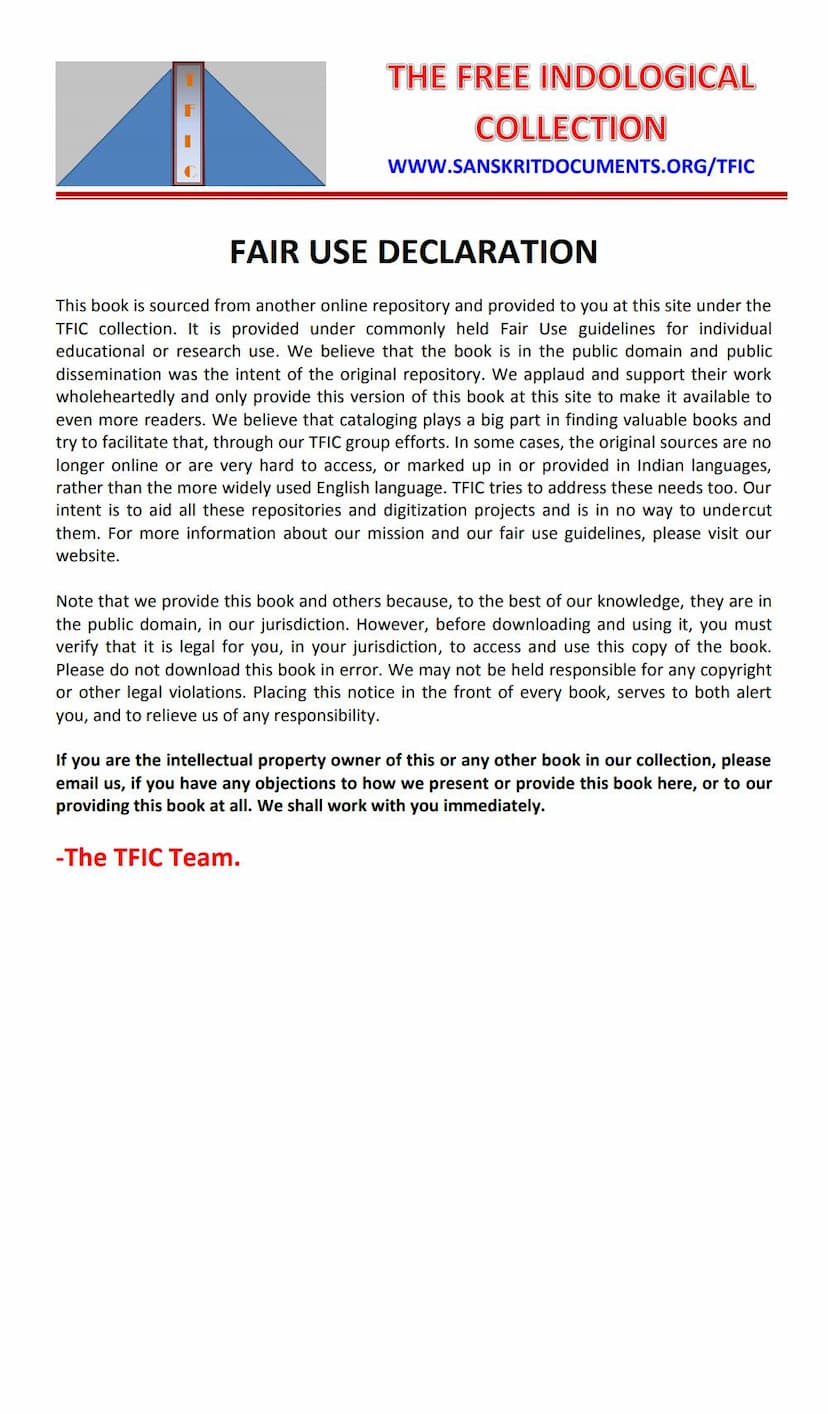Sanskrit Prakrit Jain Vyakaran Aur Kosh Ki Parampara
Added to library: September 2, 2025

Summary
This comprehensive summary synthesizes the information provided in the text, focusing on the Jain tradition's contribution to Sanskrit and Prakrit grammar and lexicography, as celebrated in the book "Sanskrit Prakrit Jain Vyakaran aur Kosh ki Parampara."
Book Title: Sanskrit Prakrit Jain Vyakaran aur Kosh ki Parampara Author(s): Chandanmalmuni, Nathmalmuni, Others Publisher: Kalugani Janma Shatabdi Samaroha Samiti Chapar Context: This book is presented as a commemorative volume, likely for the birth centenary of Acharya Shri Kalugani, and is guided by the vision of Acharya Shri Tulsi. It highlights the development and importance of Sanskrit and Prakrit grammar and lexicography within the Jain tradition, particularly within the Terapanth lineage.
Core Theme: The book delves into the rich tradition of Jain scholarship in the fields of Sanskrit and Prakrit grammar and lexicography. It emphasizes how Jain Acharyas and monks have significantly contributed to the preservation, development, and study of these languages, viewing them as essential tools for understanding and disseminating Jain philosophy and scriptures.
Key Aspects and Contributions:
-
Historical Context and Spiritual Guidance: The book begins by tracing the origins and evolution of the Terapanth tradition, emphasizing the revolutionary spirit of its founder, Acharya Bhikshu. It highlights the core tenet of seeking truth and reality, moving forward by adhering to both the new and the ancient. The spiritual guidance of Acharya Shri Tulsi and the efforts of previous Acharyas like Acharya Shri Kalugani are central to this narrative.
-
The Role of Sanskrit and Prakrit in Jainism:
- Sanskrit: The text underscores the significant role of Sanskrit in Jainism, despite Prakrit being the language of the Jain Agamas. Jain scholars and saints made substantial contributions to Sanskrit literature, using it for explaining, analyzing, and commenting on their own scriptural literature. This not only enriched Sanskrit literature but also provided a strong conceptual foundation for Jain ethical practices.
- Prakrit: The book highlights the continued study and development of Prakrit within the Terapanth sect. It mentions the proficiency of hundreds of monks and nuns in Prakrit, who actively engage in creating new literature and delivering lectures. The impetus given by Acharya Shri Tulsi and Muni Shri Nathmalji is noted for the publication of scholarly works in this area.
-
Acharya Shri Kalugani's Emphasis on Learning: The book specifically credits Acharya Shri Kalugani with a major role in promoting Sanskrit studies within the Terapanth. He emphasized profound and foundational knowledge over superficial scholarship, particularly stressing the importance of grammar. His personal rigorous study of grammar in his later years and his inspiration to his disciples are highlighted as key factors. He also initiated the study and memorization of lexicographical works like Acharya Hemchandra's Abhidhāna-cintāmaṇi.
-
Development of Jain Grammatical Works:
- Acharya Hemachandra: His contributions, particularly his Siddha-Hema-Śabdānuśāsana, are recognized as foundational. It's noted that he synthesized the works of earlier scholars like Panini, Chandragomi, and Jainendra, making Jain grammar more accessible. The Siddha-Hema-Śabdānuśāsana includes a comprehensive grammar of various Prakrit languages (Magadhi, Ardhamagadhi, Shauraseni, Paishachi, Chulika Paishachi, Apabhramsha, and Mārṣa Prakrit).
- Muni Shri Payamallji: His Bhikṣu-Śabdānuśāsana is recognized as a significant contribution to Sanskrit grammatical literature, praised for its simplified and accessible style, achieved through a deep study of various prevalent and lesser-known grammars. The historical collaboration with Pandit Raghunandan Sharma in composing a detailed commentary on this work is also mentioned.
- Muni Shri Chhothmallji: His work Kālu-Kaumudī, named in honor of Acharya Kalugani, is a concise process-based grammatical text.
- Muni Shri Sohanlalji (Churu): His Tulasīprabhā, another process-based grammar, is noted for its elegance and clarity, making grammar less arduous and more palatable.
-
Acharya Shri Tulsi's Continued Patronage: The current spiritual leader, Acharya Shri Tulsi, is credited with not only sustaining but also advancing the cause of Sanskrit learning. His childhood fondness for Sanskrit, his mastery of grammar, logic, poetry, and lexicography, as evidenced by his own profound works, are highlighted. He has also been instrumental in training numerous monks and nuns in Sanskrit, leading to the current generation of scholars within the Terapanth.
-
Academic Exchange and Recognition: The text recounts instances where scholars from Pune and Varanasi were astonished by the scholarly acumen of Muni Shri Nathmalji, particularly his Sanskrit oratory. This led to the perception of the Terapanth monastic community as a "walking university of Sanskrit learning."
-
The Genesis of the Commemorative Volume: The plan for this specific volume arose during the centenary celebrations of Acharya Shri Kalugani. Acharya Shri Tulsi directed that the memorial volume should not be merely a biographical tribute but should focus on a significant aspect of his life's work – the advancement of studies in Sanskrit, Prakrit, linguistics, and lexicography. The aim was to provide solid, research-based material that would serve as a beacon for future scholars in these fields.
-
Content and Contributors: The volume features research papers by numerous distinguished scholars on various aspects of Sanskrit, Prakrit, and Jain grammar and lexicography. The editors acknowledge the significant contributions of scholars like Muni Shri Dulahraj, Dr. Chhaganlal Shastri, and Dr. Premsuman Jain, who dedicated themselves to compiling this valuable material.
-
Thematic Focus: The collected essays explore the evolution of Sanskrit grammar within the Jain tradition, highlighting the works of scholars like Panini, Jinendra, Shakatayana, and Hemachandra. It also examines the development of Prakrit grammar, the influence of Prakrit-Apabhramsha on modern Indian languages, and the significance of Jain lexicographical works.
Overall Significance: The book "Sanskrit Prakrit Jain Vyakaran aur Kosh ki Parampara" serves as a testament to the enduring commitment of the Jain tradition, particularly the Terapanth, to the rigorous study and advancement of Sanskrit and Prakrit. It showcases the profound contributions of Jain scholars in shaping these languages and enriching Indian indological studies, all within the framework of their spiritual and intellectual heritage. The emphasis is on preserving and promoting these ancient languages for the continued flourishing of Jain knowledge and its dissemination to wider audiences.